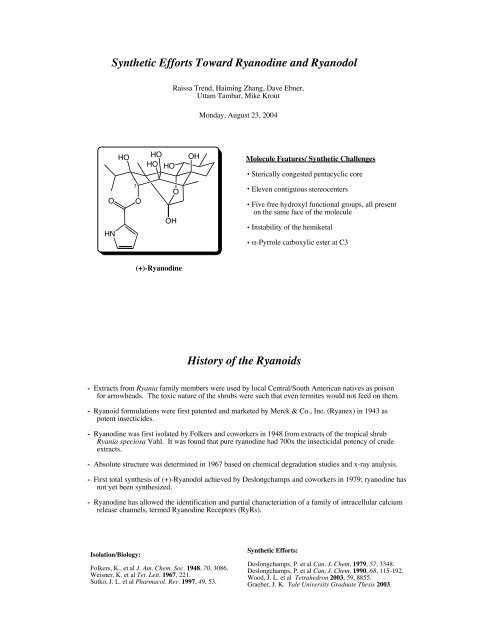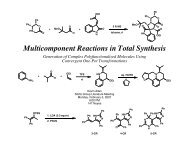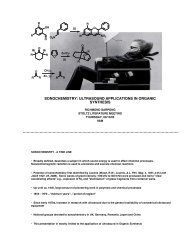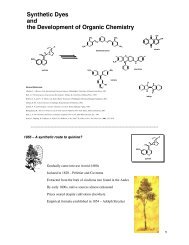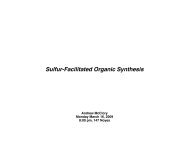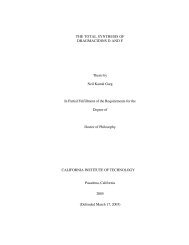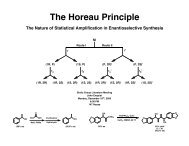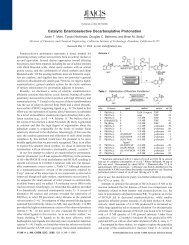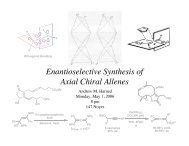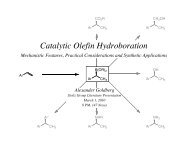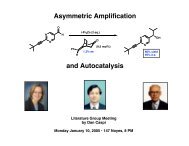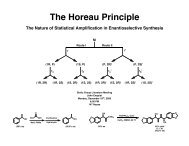Synthetic Efforts Toward Ryanodine and Ryanodol - The Stoltz Group
Synthetic Efforts Toward Ryanodine and Ryanodol - The Stoltz Group
Synthetic Efforts Toward Ryanodine and Ryanodol - The Stoltz Group
Create successful ePaper yourself
Turn your PDF publications into a flip-book with our unique Google optimized e-Paper software.
<strong>Ryanodine</strong> ReactivityHO23AROHOHO124EHO1511OHBODR=H, <strong>Ryanodol</strong>O1H10OHR=N, <strong>Ryanodine</strong>59C21- Cage-like shape of molecule prevents selective ester formationat C3; esterification occurs at C10.- Dehydration occurs in the presence of acid to formanhydroryanodine. This major degradation product waskey to elucidation of absolute structure.- Due to the bridgehead nature of the molecule, stereocentersat C1, C5, C11, C12, <strong>and</strong> C15 are geometrically related.- Deslongchamps uses this rationale to focus on setting theother six stereocenters en route to anhydroryanodol, thetargeted precursor to (+)-ryanodol.<strong>Ryanodol</strong>H 3 O +H 2 O + HOH 2 OHOHO HOOOHOHHOHOHO HOOOHOAnhydroryanodolRelated RyanoidsHOHOHO HOOHHOHOHOOHOOOOOO20OHHNOHHNOH9,21-didehydroryanodineMajor component of ryania extracts; equipotentinsecticide as ryanodine.SpiganthineIsolated from Spigelia anthelmia; found with ryanodine.HOHOHO HOOHHO18HOHOHO HOOHHOHOHOHOOH10O3 3O3OOHCinnzeylanol Cincassiol B PerseanolNon-alkaloidal ryanoids isolated from the Cinnamonum genus; insecticidal. Isolated from Persea indica, the tree thatryanodol was first isolated.OHOH
Biosynthesis <strong>and</strong> Biological Activity21310HO2HOHO HO1310OH351514OHGeranyl Geraniol3ROOOH515 14OH- Thought to be derived from geranyl geraniol; however, "the mechanism of carbon-carbon bond formation...is not obvious... nor is that of introducing the required hydroxyl functionalities."- Effects on calcium levels were known for some time, but it wasn't until 9,21-didehydroryanodine wasisolated that the receptor could be identified (via [3H]-labeled derivative)- RyRs are a family of calicum channels that release Ca from intracellular stores; physically the largest ionchannel known, RyRs exist as a homotetramer.- Underst<strong>and</strong>ing of the binding site is unclear; at low [ryanodine], the receptor is at partial (50%) to fullconductance; however, at high [ryanodine], the channel is in a closed state.- <strong>The</strong> !-pyrrole ester is necessary for biological activity; ryanodol has lost all affinity for RyR. <strong>The</strong> next mostimportant feature is the shape of the ryanoid skeleton. It is believed that ryanodine binds the receptor with thehydrophobic surface, exposing the polar alcohol functionalities.- Total synthesis efforts could provide analogs not accessible through degradation, facilitating elucidation ofbinding models, biosynthesis, binding site characteristics, <strong>and</strong> provide clues about endogenous RyR lig<strong>and</strong>s.2+Retrosynthesis of <strong>Ryanodine</strong>OH OHHO HOHOOHHOOHOH OHHO HOHO OOHOHN<strong>Ryanodine</strong>OHOH OHHO HOHOOHHO<strong>Ryanodol</strong>OHOHHO HOOHOO+OOH OHOOAnhydroryanodolOOCH 3(S)O
Synthesis of o-Spirolactone DienoneOH OHHO17 HOHOOHHOOHMeO1. CH 3 OCHCl 2 , TiCl 4 , CH 2 Cl 2HO2. BBr 3 , CH 2 Cl 2MeO80%HOCHO1. BrCH 2 COBr, Pyr, PhH2. Na 2 CO 3 , THFOOWolff-Kishner80%O80%CHOOONaOH, H 2 O, MeCN, NBSOOOCH 395%OOCH 3Synthesis of Vinylketone AcetalOH OHHO17 HOHOOHHOOHPt/H 2 , Et 2 O1. O 3 , EtOAc2. (CH 2 OH) 2 , p-TsOH, PhH3. MeI, K 2 CO 3 , CH 3 COCH 3O80%O70%from (+)-carvoneCH 3(+)-CarvoneCH 3MeO 2 COO1. NaOH, MeOH2. LiH, THF, CH 2 =CHLi75%OOO
Ozonolysis <strong>and</strong> Aldol Condensation –the C RingOH OH 10 OHHO HO11 6HOOHHO10O OOH O 3 , EtOAc, p-TsOH;6 11LDA, THF, -78°C;Me 2 SH O OH Et 3 B, -25°C; MeIO> 90%H OO70%OXHHOOOOMeOMeOO O1) NaBHH O OH4 , MeOHH OOTHF, 0°C, > 95%H O 10 OX2) MOMCl, NaH THFH O HO680% + 13% SMX11OOOOX = –CH(OCH 3 ) 2Ozonolysis <strong>and</strong> Aldol CondensationOH OHHO HOHOOHHOOHOHOOOHOOMeOMeHO 3 , EtOAc, p-TsOH;Me 2 S> 90%OHOOOOHXOOHHHXOOOOHOOOAldolHHXOOOHOOHHHXOOOHOOHHXOOOOOHOOUndesiredOOOO
Grob Fragmentation to a Macrolactone –Strategy for the D RingOH OH17HOHO11HOOHHO15OHHHXOOOO HO17O1115OO1) LAH, THF, 95%2) CrO 3 •2Py, CH 2 Cl 2-45 to -22 °C, 76%3) MsCl, Py, 0 °C,89%HHXOOO ROOR = MsOOOHO LiSDMSOHHXOOO ROOOOO –HHX17OOOOO1115OOHBF 4 , THF,0 °C92%(2 steps)X = –CH(OCH 3 ) 2HHXOOOOOOHD Ring Formation <strong>and</strong> FGIOH OH17HOHHO113OHOHO15OHHHX17OOOOO1115OH1) CF 3 CO 3 H, Na 2 HPO 4DCE, 4 °C2) NaOH, MeOCH 2 CH 2 OMe77% over 2 stepsHHXHOOOOOOOHOH1) pNBClPy, 0 °C2) CrO 3 •2PyCH 2 Cl 2 , 78%HHXOOpNBOOO17OOH1) LiBH 4 , THF-30 to -20 °C73%, + axial alcohol2) Ac 2 O, PyOH OMeO H O AcOMeO317OpNBOOHOOX = –CH(OCH 3 ) 2
Degradation of Ring AOH OHHO17 HOHOOHOHOOHOHMeO HOO AcOOHpTSAPhHHHOO AcOOHO 3 , CH 2 Cl 2-78 to -55°CMeOOpNBOOrefluxOpNB OOMeOthen Me 2 SOOOHHOO AcOOHAc 2 ONaOAcHOO AcOOHDBNPhH75°C17OO AcOOHOOpNBO100°C17AcOOpNBO50%(4 steps)OOOOOEnone Formation DetailsOH OH17HOHOHOOHOHB:OHOO AcOAcO17OOpNBOOHDBN, PhH-pNBOHB:OOHOOO AcO17OOOHHOOO-keteneOO AcOOH17OO AcOOHO17H +OOOOO
Synthesis of AnhydroryanodolOH OHHO HOHOOHHOOHOOOO AcOOHNaBH 4 , THFMeOH, 0°COO AcOOHOO! 90%HHOOOONaOH, THFOHHO HOH OHOOH3:1HOHHO HOHOOOHOOHHOOHHO HOCompletion of the SynthesisOOHNaOH, THF3:1HOHHO HOOHOOHOH OHHO HOHOOHHOOHOCF 3 CO 3 HNa 2 HPO 4 , DCEroom temp.85%OHOOHHO HOHOOOOHNaOH, THF3:2Li, NH 3THF! 60%HOOHHO HOOOHOOHOH OH OHHO HOHOOHHO(+)-ryanodol
Wood's Retrosynthetic Analysis of <strong>Ryanodine</strong>Rhodium-Mediated Claisen Rearrangement <strong>and</strong>Phenolic Oxidation / Singlet Oxygen Diels AlderOH OHHO HOHOORHOOHOOOOHOOOH OHRHOOROOOOOHOHPhenolic OxidationSinglet Oxygen Diels AlderOOHOOBnRhodium-MediatedClaisen RearrangementHOOCO 2 ROHN 2OBrBrGeneral StrategyOHOHWood's Phenolic Oxidation/Singlet Oxygen Diels AlderPhenolic [O]OOOO1 O 2OOOH OHHO HOHOOHHOOHModel System Substrate SynthesisOHO+!Cl(90% yield)OOAlCl 3 , !(45% yield)OOHHOOOH1. NaOH2. HCl(95% yield)EtOOOHH 2 , Pd(OH) 2OOBrOZn, !(52% yield)OEt3. NBS, DMF(70 %yield)EtOH(90% yield)Br
Wood's Phenolic Oxidation/Singlet Oxygen Diels Alder (cont.)Model System Validates the StrategyOH OHHO HOHOOHHOOHHOOOHPhI(O 2 CCF 3 ) 2MeCN(80% yield)OOO1 O 2(95% yield)OOOOOH 2 , Pd/CBrBrBr(95% yield)OOHOH OHOOOOHOOOHWood's Phenolic Oxidation/Singlet Oxygen Diels Alder (cont.)Strategy for the Real SystemOH OHHO HOHOOHHOOHHOOOHModelOOHOH OHHOOCO 2 HOHRealOOOHOH OHOOOOBrOBrOReal System Substrate SynthesisOOH1. NBS, DMF(70% yield)2. BnBr, K 2 CO 3(85% yield)OOBnBr1. (s-Bu)ONO,HCl (70% yield)2. NH 2 Cl, H 2 O/THF(78% yield)N 2OOBnBr
Wood's Phenolic Oxidation/Singlet Oxygen Diels Alder (cont.)Real System Validates the StrategyOH OHHO HOHOOHHOOHHO2 steps(80% yield)BnOOOEtLiCuMe 2(85% yield)BnOOOEtOOBnOOBnDIBAL-H(72% yield)L n RhRh 2 (OAc) 4!, PhH(62% yield)N 2+BnOOHBrBrOBnHOL n RhOOBnOBnOHOOBn[3,3]OHOOBnOHBrBrBrConcluding RemarksOOH OHHO HOHOOOHHONH– Lack of obvious disconnections– Many hydroxyls vs. compact polycyclic structure– Inclusion/installation of the pyrrole ester moiety– Synthesis of the C 6 –C 11 trans diol"...it can be concluded from this analysis that ryanodol is indeed a very complex diterpene..." – Deslongchamps


